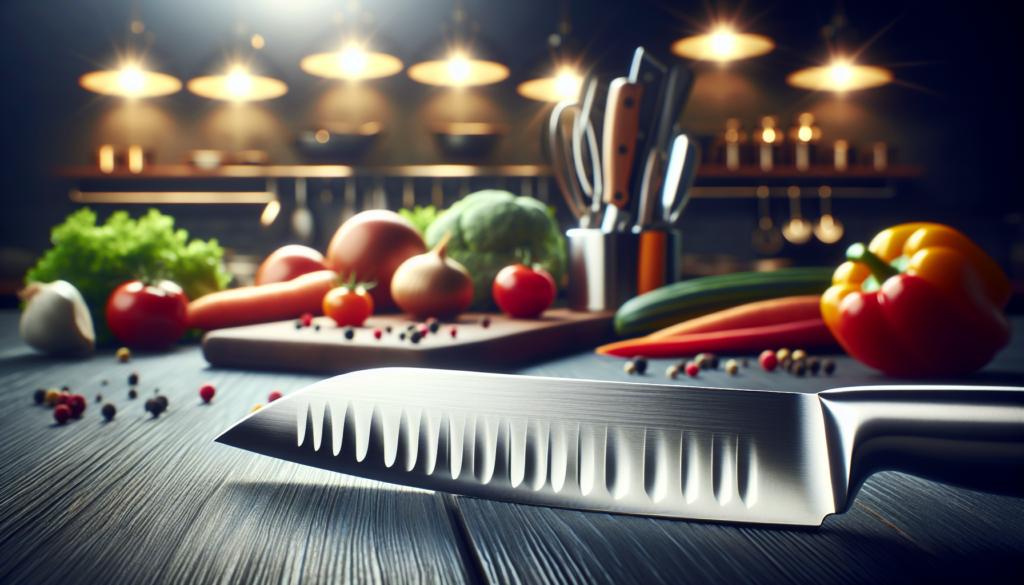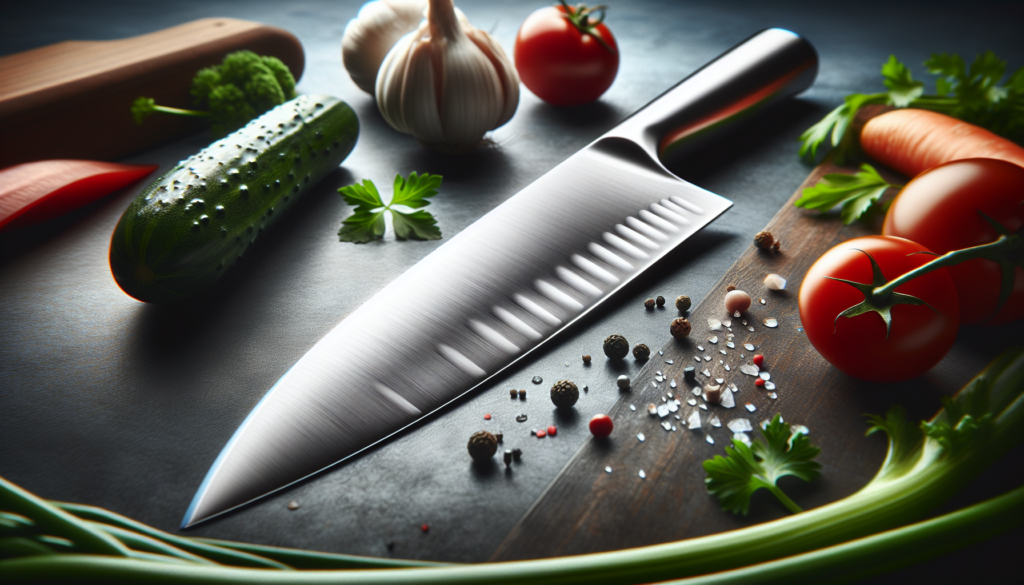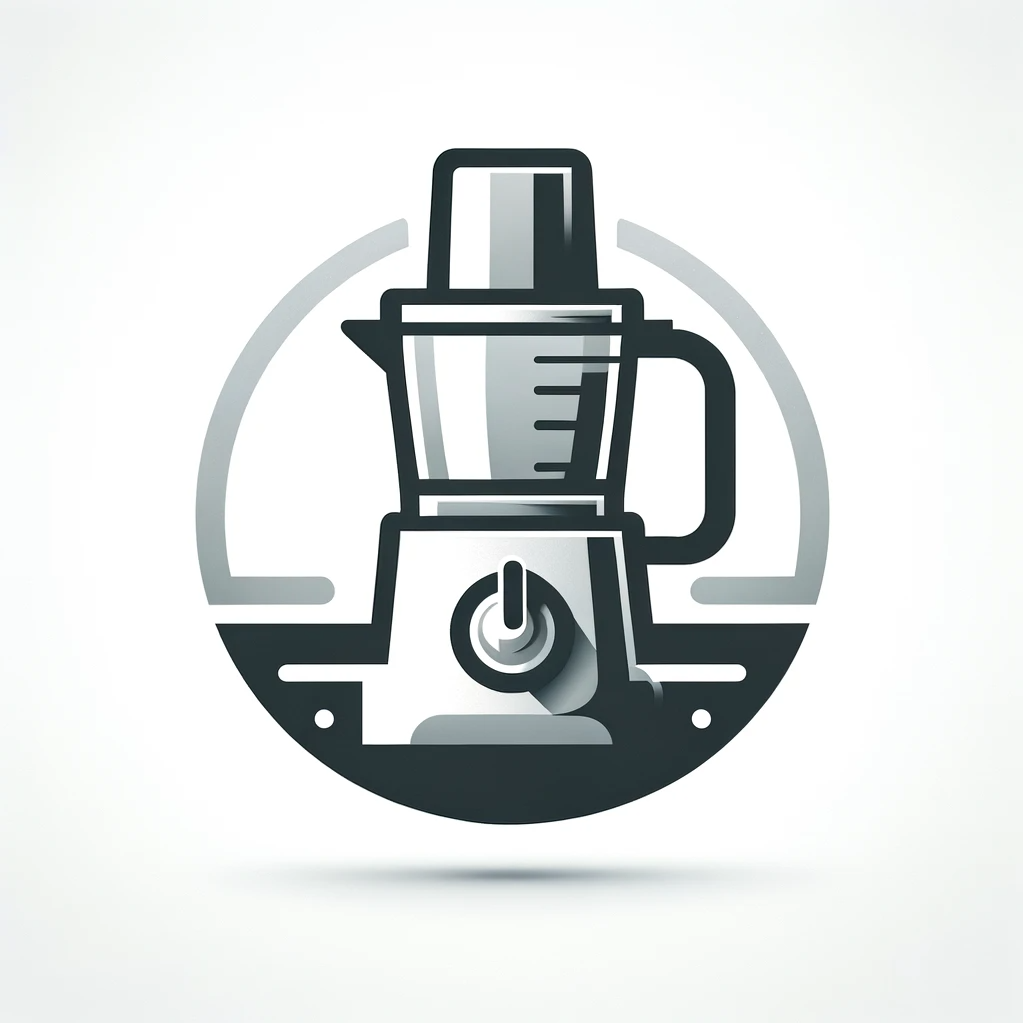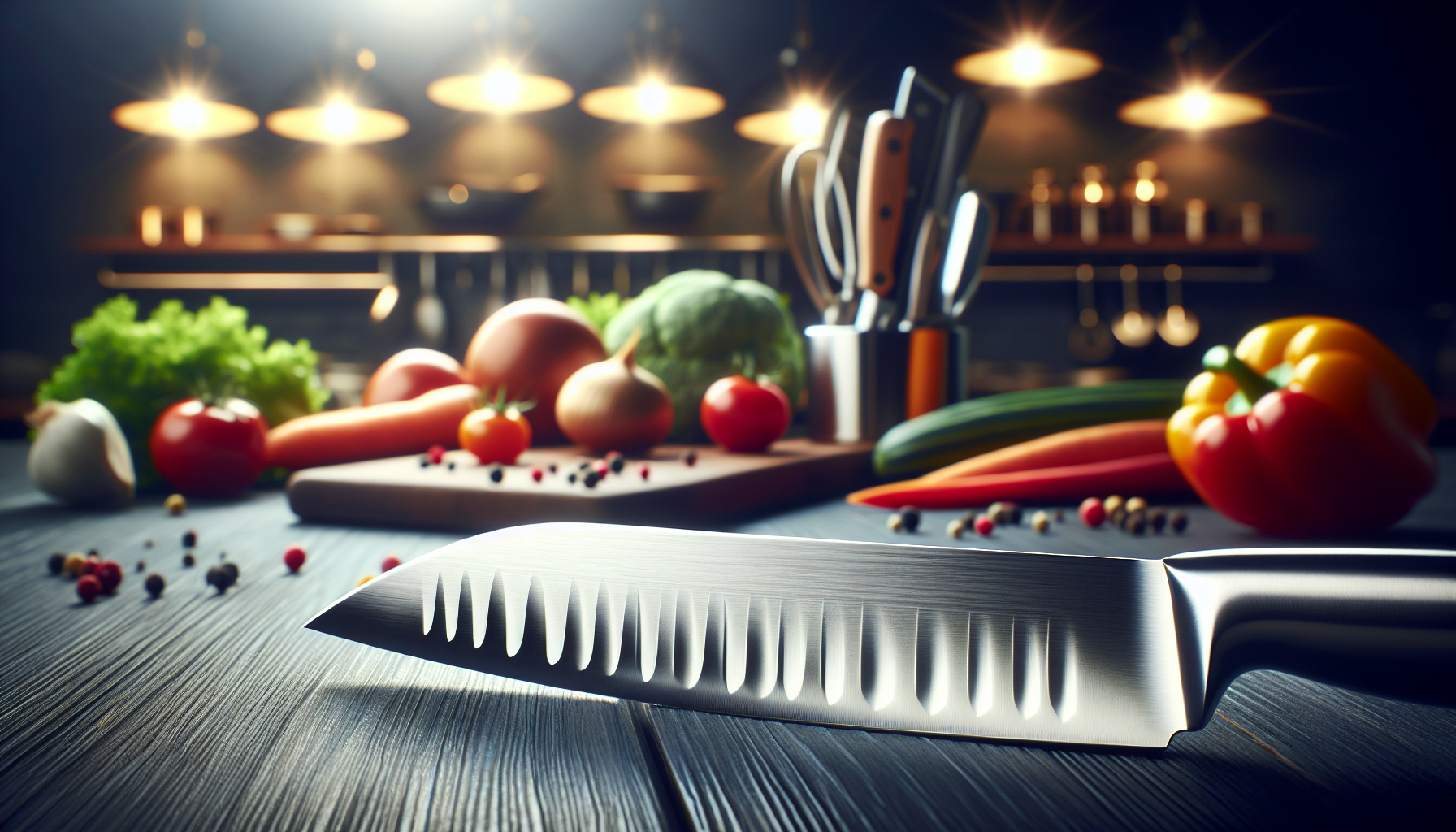Are you tired of struggling to find the perfect tool for cutting vegetables? Look no further! In this article, we will explore the various options available and help you discover the ultimate tool to make your vegetable cutting tasks a breeze. Say goodbye to uneven slices and hello to perfectly chopped veggies in no time! So, let’s get started and find out which tool will become your new kitchen companion.
Chef’s Knife

CHECK OUT FOOD PROCESSORS AND VEGETABLE CHOPPERS ON AMAZON
1.1. Description
A chef’s knife is a versatile and essential tool in any kitchen. It typically has a broad, sharp blade ranging from 6 to 12 inches in length. The blade is curved, allowing you to rock the knife back and forth while cutting. The handle is designed to provide a comfortable grip and control.
1.2. Advantages
The chef’s knife has several advantages that make it a go-to tool for cutting vegetables. Firstly, its sharp and wide blade enables you to cut through vegetables with ease, whether it’s slicing, dicing, or chopping. The curved shape of the blade allows for efficient rocking motion, which enhances your speed and precision while cutting. Moreover, the weight and balance of the chef’s knife ensure stability, reducing the chances of accidents during vegetable prep.
1.3. Disadvantages
Despite its many benefits, the chef’s knife does have a few disadvantages. One potential downside is its larger size, which may not be suitable for smaller hands or delicate tasks. Additionally, the chef’s knife requires proper technique and practice to master. Beginners may find it initially challenging to control and maneuver, which could lead to uneven cuts or accidents.
1.4. Tips for Using
To make the most out of your chef’s knife, here are a few tips for using it effectively:
- Grip the handle firmly but not too tightly, maintaining a comfortable hold.
- Ensure your cutting surface is stable to prevent slips and injuries.
- Use a claw grip to position your non-dominant hand while holding the vegetable, keeping your fingers safe.
- Practice proper cutting techniques, such as the rocking motion, to enhance your speed and precision.
1.5. Maintenance
Proper maintenance is crucial to keep your chef’s knife in top condition for years to come. Here are a few maintenance tips:
- Hand wash your knife with warm, soapy water after each use. Avoid placing it in the dishwasher as it can damage the blade and handle.
- Dry the knife thoroughly to prevent moisture buildup and potential rusting.
- Regularly sharpen the blade using a sharpening stone or honing rod to maintain its sharpness. Consider professional sharpening if needed.
- Store your chef’s knife in a knife block or on a magnetic strip to protect the blade and prevent accidents.
Santoku Knife
2.1. Description
The Santoku knife is a Japanese knife that has gained popularity worldwide. It typically features a shorter, wide blade with a flat edge and a pointed tip. The name “Santoku” translates to “three virtues” in Japanese, representing its versatility in slicing, dicing, and mincing.
2.2. Advantages
The Santoku knife offers several advantages for cutting vegetables. Its shorter and wider blade provides better control and manoeuvrability, making it ideal for precision work. The flat edge allows for a clean and straight slicing motion, ensuring even cuts. Additionally, the pointed tip helps with detailed tasks, such as removing seeds or creating decorative cuts.
2.3. Disadvantages
While the Santoku knife has its advantages, it also has a few disadvantages to consider. The relatively shorter blade may not be suitable for cutting larger vegetables or tackling heavy-duty tasks. Additionally, the flat edge can be less effective for tasks that require a rocking motion, such as mincing herbs. It’s important to assess your specific needs before choosing this knife.
2.4. Tips for Using
To make the most of your Santoku knife while cutting vegetables, keep these tips in mind:
- Hold the handle with a firm grip and maintain control throughout the cutting process.
- Use a chopping or push-cutting motion, utilizing the flat edge for precise and clean slices.
- For larger vegetables, consider using a rocking motion to ensure efficient cutting.
- Take advantage of the pointed tip for intricate tasks like removing seeds or making decorative cuts.
2.5. Maintenance
To maintain the performance and longevity of your Santoku knife, follow these maintenance tips:
- Hand wash the knife with warm, soapy water after each use. Avoid soaking it for long periods as it can damage the handle.
- Dry the knife thoroughly to prevent moisture buildup and potential rusting.
- Regularly sharpen the blade using a sharpening stone or honing rod to retain its sharpness.
- Store the Santoku knife in a knife block or on a magnetic strip, ensuring the blade is properly protected.
Paring Knife
3.1. Description
A paring knife is a small, versatile knife with a thin and narrow blade usually around 3 to 4 inches in length. It is designed for intricate tasks that require precision, such as peeling, trimming, and slicing small fruits and vegetables.
3.2. Advantages
The paring knife offers several advantages when it comes to cutting vegetables. Its small and maneuverable size allows for intricate and delicate work with ease. This makes it perfect for peeling the skin off vegetables or removing blemishes. The sharp and narrow blade ensures precise and controlled cuts, leaving minimal waste.
3.3. Disadvantages
Despite its versatility, the paring knife does have a few disadvantages. Its small size may not be suitable for cutting larger or more robust vegetables, as it lacks the leverage of larger knives. Additionally, the narrow blade may require more passes to make the desired cuts, which can be time-consuming for tasks like chopping.
3.4. Tips for Using
To make the most out of your paring knife while cutting vegetables, consider these tips:
- Hold the handle firmly and maintain control throughout the cutting process.
- Use short, controlled movements to enable precise cuts.
- Start by peeling or trimming the vegetable’s skin before moving on to other tasks.
- Avoid applying excessive pressure to prevent the blade from slipping.
3.5. Maintenance
Here are some maintenance tips to keep your paring knife in optimal condition:
- Hand wash the knife with warm, soapy water after every use, being careful around the slender blade.
- Dry the knife thoroughly to prevent moisture buildup and potential rusting.
- Regularly sharpen the blade using a sharpening stone or honing rod to maintain its sharpness.
- Store the paring knife in a knife block or sheath to protect the blade and prevent accidents.
Vegetable Cleaver
4.1. Description
A vegetable cleaver, also known as a Chinese cleaver or chef’s cleaver, is a broad, rectangular knife with a straight edge and a sharp, thick blade. It is designed for heavy-duty tasks, including chopping, slicing, and mincing vegetables.
4.2. Advantages
The vegetable cleaver offers several advantages when it comes to cutting vegetables. Its large, heavy blade allows for efficient chopping and slicing, reducing the effort and time required. The broad surface area also provides stability, making it easier to control and preventing accidents. Additionally, the flat edge can be used for smashing garlic or ginger, adding versatility to the tool.
4.3. Disadvantages
Despite its advantages, the vegetable cleaver does have a few disadvantages to consider. Its size and weight may make it challenging for individuals with smaller hands or those who prefer lighter knives. Its purpose-built design for chopping may limit its versatility in precise tasks or delicate cuts.
4.4. Tips for Using
To make the most of your vegetable cleaver while cutting vegetables, follow these tips:
- Grip the handle firmly, ensuring you have control over the heavy blade.
- Use a chopping motion by bringing the cleaver down onto the vegetables, taking advantage of its weight and size.
- Utilize the broad blade for crushing garlic or ginger, adding flavor to your dishes.
- Be mindful of your fingers and maintain proper technique to avoid accidents.
4.5. Maintenance
Ensure your vegetable cleaver stays in excellent condition with these maintenance tips:
- Hand wash the knife with warm, soapy water after each use, as the broad blade may not fit in a dishwasher.
- Dry the knife thoroughly to prevent moisture accumulation and potential rusting.
- Regularly sharpen the blade using a sharpening stone to maintain its sharpness.
- Store the vegetable cleaver in a knife block or a designated spot to protect the blade and prevent accidents.
Mandoline Slicer
5.1. Description
A mandoline slicer is a kitchen tool used for slicing vegetables and fruits with precision. It typically consists of a flat surface with adjustable blades and a handguard to protect your fingers while slicing.
5.2. Advantages
The mandoline slicer offers several advantages when it comes to cutting vegetables. Its adjustable blades allow you to achieve consistent slices of varying thickness. This is particularly useful for creating uniform slices for dishes like gratins, salads, or even vegetable chips. The handguard ensures safety, protecting your fingers from accidental cuts while providing stability and control.
5.3. Disadvantages
While the mandoline slicer is a handy tool, it is important to be aware of its disadvantages. The blades are very sharp, requiring cautious handling to avoid accidents. Additionally, it may not be suitable for cutting softer vegetables or smaller items that are difficult to secure on the flat surface.

CHECK OUT FOOD PROCESSORS AND VEGETABLE CHOPPERS ON AMAZON
5.4. Tips for Using
To make the most of your mandoline slicer when cutting vegetables, consider these tips:
- Familiarize yourself with the adjustable blades and choose the desired thickness for your slices.
- Take your time and use a smooth, controlled motion to avoid any strain or accidental slips.
- Place the vegetable securely on the flat surface, ideally using the handguard for added protection.
- Clean the mandoline slicer thoroughly after each use to prevent buildup and maintain blade sharpness.
5.5. Maintenance
Maintain the performance and longevity of your mandoline slicer with these maintenance tips:
- Hand wash the slicer with warm, soapy water after each use.
- Pay extra attention to cleaning the blades, making sure to remove any trapped food particles.
- Dry the slicer thoroughly to prevent moisture accumulation and potential rusting.
- Store the mandoline slicer in a safe and accessible location, ensuring the blades are properly protected.
Box Grater
6.1. Description
A box grater is a kitchen tool commonly used for grating or shredding vegetables, cheese, and other ingredients. It consists of multiple sides or surfaces with different sizes of grating holes.
6.2. Advantages
The box grater offers several advantages when it comes to cutting vegetables. Its multiple grating surfaces allow you to achieve different textures and thicknesses, whether it’s fine grated cheese or coarsely shredded vegetables. The sturdy construction and handle provide stability and control while grating, ensuring precise and consistent results.
6.3. Disadvantages
Despite its versatility, the box grater does have a few disadvantages to consider. It can be challenging to clean thoroughly, especially in the small crevices between the grating surfaces. Additionally, it may not be suitable for creating uniform slices or precise cuts, as it is primarily designed for grating or shredding.
6.4. Tips for Using
To make the most out of your box grater when cutting vegetables, follow these tips:
- Familiarize yourself with the different sides of the grater and choose the appropriate one for your desired texture.
- Hold the handle firmly and apply steady pressure while grating, ensuring stability and control.
- Be cautious of your fingers and use a handguard if necessary to prevent accidental cuts.
- Clean the box grater thoroughly after each use, paying extra attention to the grating surfaces and crevices.
6.5. Maintenance
Maintain the performance and longevity of your box grater with these maintenance tips:
- Hand wash the grater with warm, soapy water after each use, using a brush to remove any stuck particles.
- Dry the grater thoroughly to prevent moisture buildup and potential rusting.
- Store the box grater in a dry location or drawer, ensuring it is properly cleaned and protected.
Vegetable Peeler
7.1. Description
A vegetable peeler is a handheld kitchen tool designed specifically for peeling the skin off vegetables and fruits. It typically consists of a handle with a sharp, swiveling blade at the end.
7.2. Advantages
The vegetable peeler offers several advantages when it comes to cutting vegetables. Its sharp blade allows for effortless peeling, saving time and minimizing food waste. The lightweight and ergonomic design make it easy to use and maneuver, even for individuals with limited hand strength or mobility.
7.3. Disadvantages
Although the vegetable peeler is a handy tool, it does have a few disadvantages to consider. Its primary function is peeling, making it less suitable for cutting tasks that require more precision or thickness control. Additionally, it may not be as effective for peeling certain vegetables with irregular shapes or tougher skins.
7.4. Tips for Using
To make the most out of your vegetable peeler when cutting vegetables, keep these tips in mind:
- Hold the peeler firmly but gently, allowing the blade to glide smoothly across the vegetable’s surface.
- Peel away from your body to minimize the risk of accidental cuts.
- Take your time and apply even pressure to ensure consistent and clean peeling.
- Consider using a paring knife or other tools for more intricate cutting tasks.
7.5. Maintenance
Ensure your vegetable peeler stays in excellent condition with these maintenance tips:
- Hand wash the peeler with warm, soapy water after each use.
- Dry the peeler thoroughly to prevent moisture buildup and potential rusting.
- Regularly check the blade’s sharpness and consider replacing it if it becomes dull.
- Store the vegetable peeler in a drawer or utensil holder, protecting the blade and ensuring easy accessibility.
Kitchen Shears
8.1. Description
Kitchen shears, also known as kitchen scissors, are a versatile tool designed to tackle various tasks in the kitchen. They typically feature strong, slightly serrated blades with comfortable handles for easy use.
8.2. Advantages
Kitchen shears offer several advantages when it comes to cutting vegetables. Their versatility allows for a wide range of applications, such as trimming herbs, snipping greens, or even cutting through poultry bones. The serrated blades provide added grip and prevent slippage during cutting, ensuring safety and control.
8.3. Disadvantages
Despite their versatility, kitchen shears do have a few disadvantages to consider. The serrated blades may leave behind uneven edges when cutting certain vegetables with delicate textures. Additionally, they may not be as effective for tasks that require precise and clean cuts, where a sharper knife or specialized tool may be more appropriate.
8.4. Tips for Using
To make the most of your kitchen shears when cutting vegetables, consider these tips:
- Hold the shears with a firm grip, positioning your fingers near the pivot point for better control.
- When trimming herbs or snipping greens, use short, decisive cuts to avoid crushing or bruising the leaves.
- Avoid cutting through hard or thick vegetable stems to prevent damage to the shears.
- Clean the shears thoroughly after each use, especially if they come into contact with sticky or oily vegetables.
8.5. Maintenance
Maintain the performance and longevity of your kitchen shears with these maintenance tips:
- Hand wash the shears with warm, soapy water after each use, paying attention to any food residue or debris.
- Dry the shears thoroughly to prevent moisture buildup and potential rusting.
- Regularly check the blades’ sharpness and consider sharpening if necessary.
- Store the kitchen shears in a drawer or hang them using a magnetic strip, ensuring the blades are protected and easily accessible.
Food Processor
9.1. Description
A food processor is an electric kitchen appliance that helps with various food preparation tasks, including cutting, chopping, pureeing, and mixing. It typically consists of a motorized base with different attachments and a large capacity bowl.
9.2. Advantages
The food processor offers several advantages when it comes to cutting vegetables. Its motorized base and sharp blades allow for quick and effortless chopping and slicing. The large capacity bowl enables you to process a significant amount of vegetables at once, saving time and effort. Additionally, some food processors come with various attachments, such as slicing discs or julienne blades, providing versatility in cutting techniques.
9.3. Disadvantages
While the food processor is a versatile tool, it does have a few disadvantages to consider. The electric-powered nature of the appliance may limit its portability and require access to a power source. Additionally, the large size of some food processors may take up valuable counter or storage space in your kitchen.
9.4. Tips for Using
To make the most out of your food processor when cutting vegetables, consider these tips:
- Familiarize yourself with the different attachments and blades, selecting the appropriate one for your desired cutting technique.
- Cut vegetables into smaller, uniform pieces prior to processing to ensure more consistent results.
- Avoid overcrowding the bowl and process in batches if necessary, ensuring the vegetables are evenly processed.
- Clean the food processor immediately after use, as dried or stuck residues can be difficult to remove.
9.5. Maintenance
Here are some maintenance tips to keep your food processor in optimal condition:
- Refer to the manufacturer’s instructions for cleaning and maintenance specific to your model.
- Hand wash the removable parts, such as the bowl, lid, and blades, with warm, soapy water after each use.
- Dry the parts thoroughly before reassembling or storing to prevent moisture buildup.
- Store the food processor in a clean and dry area, ensuring all components are properly cleaned and protected.
Spiralizer
10.1. Description
A spiralizer is a kitchen tool used to create long, spiral-shaped strands or ribbons from vegetables. It typically features multiple blade attachments that can create different shapes and sizes of vegetable noodles or “zoodles.”
10.2. Advantages
The spiralizer offers several advantages when it comes to cutting vegetables. It allows for creative and healthy alternatives to traditional pasta by transforming vegetables into noodles. The various blade options provide versatility, enabling you to experiment with different shapes and sizes. Additionally, spiralizing can add texture and visual appeal to your dishes.
10.3. Disadvantages
Despite its versatility, the spiralizer does have a few disadvantages to consider. It is primarily designed for creating noodle-like shapes and may not be as effective for precise cuts or other cooking techniques. Additionally, some vegetables may not spiralize as well, leading to uneven or fragile strands.
10.4. Tips for Using
To make the most of your spiralizer when cutting vegetables, keep these tips in mind:
- Choose vegetables that are firm and have a uniform shape for optimal results.
- Trim the ends of the vegetable and secure it firmly onto the spiralizer before starting.
- Apply gentle and steady pressure when turning the handle to create consistent and smooth strands.
- Clean the spiralizer promptly after use, as leftover vegetable pulp can be challenging to remove.
10.5. Maintenance
Maintain the performance and longevity of your spiralizer with these maintenance tips:
- Hand wash the spiralizer with warm, soapy water after each use, paying attention to the blades and other removable parts.
- Use a brush or toothpick to remove any stuck vegetable particles from the blades.
- Dry the spiralizer thoroughly to prevent moisture buildup and potential rusting.
- Store the spiralizer in a clean and dry area, ensuring the blades and other components are properly cleaned and protected.
As you can see, there are various tools available to help you cut vegetables efficiently and precisely. Whether you prefer the versatility of a chef’s knife, the precision of a paring knife, or the creativity of a spiralizer, each tool has its unique advantages and considerations. By understanding their descriptions, advantages, disadvantages, tips for using, and maintenance requirements, you can choose the best tool or combination of tools that suit your needs and enhance your vegetable cutting experience. Happy cooking!

